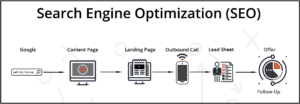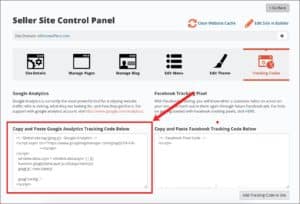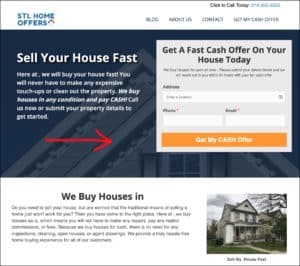CHAPTER
07
Design Your SEO Strategy to Rank For Top Keywords in Your Market
In all the previous chapters we talked about traditional offline marketing channels, like Direct Mail and Bandit Signs on Wheels.
In this chapter we are going to introduce a powerful, yet sometimes overlooked marketing channel that is done completely online.
More real estate investors are starting to use online marketing methods to help capture leads, build their brand, and set themselves apart from their competition.
One of the most important online marketing methods for your business is Search Engine Optimization (SEO).
Not sure what SEO is?
Don't worry we'll cover it in detail, but in short it's the process of maximizing the number of visitors to your website by ensuring your site appears high on the list of results returned by a search engine.
This is important for your business because it will help improve your website's overall search ability and visibility.
If you’re an investor who runs a motivated seller website, this chapter will be a comprehensive outline of what you need to do in order to optimize your site, increase rank, and start bringing in more organic leads.
So let’s begin with the definition of SEO, and the pros and cons of SEO as a marketing channel for real estate investors.
What is Search Engine Optimization (SEO)? And what is it not?
SEO (search engine optimization) is optimizing your site to try and rank (or show up) when your target customer makes searches related to what you do. It’s not a quick checklist of things to do. It’s an ongoing effort to make your site visible when people use search engines.
The goal is to increase your organic traffic (the number of website visitors you have), and help you improve ranking over time.
It’s not a quick way to make money or gain leads. It takes time, effort, and investment.
Pros and Cons of SEO
Just like any other marketing channel, SEO isn't perfect. All marketing channels require work, strategy, and perseverance. There is no magic solution where you can simply press a button, and just start increasing leads or printing money.
Each marketing channel has its own pros and cons. For example, PPC is wonderful in that you can start driving leads and traffic almost immediately. But as a con, it’s expensive, needs to be honed-in over time, and once you stop paying, your lead flow stops.
So what are the pros and cons of SEO as a marketing channel for real estate investors?
Pros
- There’s more trust in organic results. Think about it this way – if you search for “REI mentor”, and you see that the first 3 results say “sponsored”, you know that those coaches paid to get in front of you, and aren’t necessarily there by merit. But if you scroll down to the #1-3 results, you’d assume that they are there because they’re the best, right?
- You can get ongoing, organic leads without spending money in an ongoing way. Once you stop paying for ads, your leads stop. But once you start ranking well, you may continue to get leads for months or years after, as long as you stay up top.
- The leads can be really valuable. What’s the ROI for ranking in the top 3 results for “sell house for cash Houston”? Well, optimistically, if it brings 500 people a year to your site, and 100 filled out forms to request an offer (20% conversion rate), and you closed 10 deals, that’s potentially $30,000 – $100,000 each year in value (depending on your deal structures and margins).
Cons
- It takes a lot of work. Ranking in Google is harder than it’s ever been. It takes work, persistence, and knowing what you’re doing.
- It’s competitive. As with PPC, the real estate investor market is flooded with people opening up new sites every week in your geographic area.
- Some factors are out of your control. One ranking signal Google may be using is domain age or domain registration length. Meaning, if a domain has been registered for longer, without showing spammy behavior, it’s going to rank higher. You’re going up against competitors that have had websites 5 years before you, more links than you, and more traffic than you. It won’t be easy to outrank them.
- It takes time. Ranking won’t happen overnight, no matter what some agencies or gurus will tell you. You could start getting organic leads in anywhere from 3 months to 6 months, or you may need more time to begin getting on page 1.
Start optimizing your website today, so it will show up when someone searches "Sell My House Fast" online.

What you'll need:
- Keyword research
- Use phrases that motivated sellers are actually using to look for services like yours to help your site rank.
- Content Page
- Add content to your website that will use the keywords you picked, and covers the topic you're writing about.
- Landing Page with Lead Form
- Drive leads to a landing page explaining what your business does, and how you can help those leads, so you can capture leads 24 hours a day.
- Trackable Phone Number
- Use a unique phone number on your site so you can track which inbound calls are coming from your online marketing efforts. You can also make outbound dials and track which calls are answered, and create automated text & ringless voicemail campaigns for those that were not.
- Lead Sheet
- Leverage the lead sheets inside REI BlackBook to input the data you have collected from your prospects. Simply type in their information, and REI BlackBook does the rest. The property is automatically entered into your Property Pipeline, and your new lead is simultaneously entered as a new contact.
Use this lead generation method if you...
- ...have patience - This method requires you to have a marathon. Mindset, and will take some time to start producing leads.
- ...are operating on a tight budget - You can get motivated seller leads fairly cheap with this method as long as you have the time to commit to optimizing your website yourself.
- ...have basic knowledge of technology - You'll need basic web page editing ability with this ability.
Okay, so now that we have some of the basics out of the way, what are the steps to actually ranking your real estate investor website, and increasing organic leads?
Step 1: Analytics & Goal Tracking
The first thing you’re going to want to do is set up analytics and goal tracking. You’ll want to start with this, because it will help you track your progress.
Think about it this way: you don’t want to try setting up analytics after you’ve finished optimizing your website, because if you do end up seeing improvements right away, you won’t have a good picture of what traffic looked like before the improvements you made.
The basics of analytics and goal tracking:
Setup a Google Analytics account.
To utilize Google Analytics you will set-up your website, and integrate the tracking code. You can easily do this inside your REI BlackBook account.
After your website has been created you can integrate the tracking code. In the control panel of your website there is a tracking codes section where you can insert your Google Analytics Tracking code. For more details on how to add Google Analytics to your website you can check out the article How to Add your Google Analytics to your Website.

Set up goals.
Once you have analytics set up, create goals inside analytics that will capture when someone completes an action you want to track. For example, if a motivated seller fills out a form, set that up as a goal. If they complete a 2-step form and go to a “thank you” page, make that a separate goal.
Later, you’ll use these goals to work backward and see if any of them came from organic searches (in other words, this is how you measure ROI from SEO).
Build all basic local citations.
This requires paying for a citation building service. You can use a 3rd party service to do it for you. Moz Local is a great place to try.
Step 2: Set Up Google My Business
After you have goal tracking and analytics in place, it’s time to set up and optimize your Google Business listing. If you haven’t already, create your business profile on Google My Business.
From there, you’ll want to register your physical address. Having one is crucial to ranking well for local searches, and unfortunately, a temporary address (like from a UPS Store, etc.) won’t fly.
We find many investors are resistant to using their home address, but often, this is the easiest and best way to get started. If you have a coworking space that you work in, and they can grant you an address, then by all means, use that!
To verify your address, Google will send you a postcard with a verification code. Simply log into your GMB account and enter the code.
Besides registration and verification, you’ll also want to describe your services in detail, and begin to solicit reviews (something we’ll talk about later).
A few words of warning:
Don’t be spammy with your Google Business listing.
Yes, you may see others titling their business name “We Buy Houses Houston – Sell House Fast Houston – ABC Buyers”, but we’d encourage you to stick to your actual LLC or operating business name.
Step 3: Research
Alright, you’re analytics, goal tracking, citations, and Google My Business are all in place and ready to go. Before you start with any optimization, you need to do some keyword research.
This basically means that you’re using SEO tools (paid and free) and researching:
- What phrases motivated sellers are actually typing in to look for services like yours (vs. ones that are tire-kickers or looking for a Realtor, not selling for cash)
- Of those phrases, how many searches/month does each get, and which should be the primary phrases you target and go after?
- Which phrases you can get competitive with, that may be unique to your geo area (city).
A great tool to get you started for free is Moz’s Keyword Explorer. You’ll be able to make a limited number of searches to cut your teeth on keyword research and gather some data.
Again, the point is to determine what phrases are niche enough that you can actually rank for them and get found, while at the same time, driving enough traffic to be worth optimizing for on your site.
Hint: there are usually 2-3 primary keywords, and the rest can serve as supporting keywords.
After you find the keywords you want to track, you’ll need to add them to a keyword tracking tool. This will let you measure where your site is ranking at the very beginning, through the end of your SEO work.
The tool should show you where your site is ranking for each search phrase, both within the target city, and nationally. This will be the main metric you’ll want to track as you go along, because if you aren’t increasing in rankings, then you aren’t going to increase in traffic, leads, or closes.
Step 4: Content Creation
Once you’ve done your research, and have a list of all the keywords you want to rank for, and you’ve set up reporting to track them, it’s time to create some content for your site. Here are the steps for this part:
First, determine which pages should rank for what terms.
This is really important. You can’t rank every page for every keyword. It doesn’t work like that. You’ll need to decide which pages should rank for certain terms, and organize your site accordingly.
For example, say you want to rank for a few foreclosure-related keywords. You may decide that building a specific foreclosure page, explaining the process, is going to be better to rank than trying to get your homepage to rank for that.
In the end, it’s up to you, and this is where the strategy comes in. The goal is to get a single page ranking for all the relevant terms it can… but then when a term just doesn’t fit, breaking it off into its own page which ranks for its own cluster of keywords.
Next, it’s time to create the actual content.
Now that you have a visual map or layout of what pages should rank for what keywords, it’s time to actually write the content.
Now, many of you may be using the ready-made content REI BlackBook produces for you that is available on each website template. And that’s fine, except you’ll still need to write your own (or throw out the stock stuff entirely and re-write from the ground up). Here’s why:
- If you don’t, you’ll literally look like everyone else in your target city who is using the same content, with no competitive advantage.
- The stock content likely isn’t targeting all the keywords you want, isn’t long enough, and probably doesn’t even sound like your “voice”. You’ll want to write something in your own voice that connects to motivated sellers, and less like a canned copy.
Aim for content that is long enough to be fully-comprehensive, so that each page is fully covering the topic you’re trying to write about, leaving no major questions unanswered.
Once you have all the copy written, you can build out the pages, creating new content, or add the copy to existing pages and enhance existing content. Again, this requires some strategy and planning, and in the end, it’s up to you and your goals.

Step 5: On-Site Optimization
Now that you’re content is written, and the pages are built or enhanced with it, it’s time to optimize. On-site is basically laying out the page(s) in such a way that all the confirmed ranking signals Google looks for, will be there.
This includes everything from having the right “density” of keywords to the file names of your images, outbound links, headings, metadata, and more. We’ve found there are roughly 13 (depending on how you count) that matter the most.
You’ll want to go through and optimize each page that you’re trying to get to rank. One pro tip is to go down a checklist of all the major signals and check it off one by one to make sure each page has what search engines will be looking for.
Everything up until now is considered “on-site optimization”, making up the 1st half of SEO. Now we’ll move to the 2nd half: off-site optimization.
Off-site optimization
At this point, all the optimization on your site is done. From the analytics and tracking to the copy, to the way you’ve optimized your pages.
All that is only 50% of the work. The rest comes from building signals that Google looks at off of your site (hence the name, “off-site optimization”).
Truth be told, there are over 200 signals that Google weighs at any given time to know where to rank your site. SEOs don’t know all of them. No one has access to the full algorithm except Google. And it’s impossible to turn the investors reading this article into professional SEOs in 3,000 words.
So here we’re just focusing on two of the most major, change-making off-site signals: reviews and link building.
Step 6: Review Building
The first off-site signal to focus on is increasing the number of Google Business reviews you have. Some users ask us whether or not it’s helpful to get reviews on places like Yelp, or Facebook.
While it does appear that Google is taking note of Facebook reviews for your business, we always recommend that the best use of your finite time is to solicit reviews for your Google listing. After all, the one thing you know for sure is that Google is ultimately only going to want people to use it more and more.
The best way we have found to do this is to find the direct link to your reviews area, and send that to clients every time you close with them, or send it to past clients and ask them to leave you a review. If you tell clients, “find us on Google and leave a review” it’s just not going to happen. People are lazy. So make it easy for them.
A really easy way to do this is to search for your business name and find your business listing. Click “leave a review”. Then copy and paste the URL into an email or text message (however you’re asking them to leave you a review)
If you want to take it a step further, you can always use Bitly, or REI BlackBook has made this easy for you.
Inside your REI BlackBook account there is a tool called Campaign Tracker, and within this tool you can track how many people access your Google review link, and you can also create a unique shortened link to share with clients.
Once you have the shortened link share this link on social, email, text message, wherever you’re communicating with customers.
![]()
The goal here is not to get 50 on day 1 (that would be suspicious), it’s to have a sustainable way to increase reviews over time. If you can get 10 in your first 2 months, that’s great! If you can get 50 in a year, even better! The more, the better.
Step 7: Link Building
The second major off-site signal you’ll need to continue building over time is links. A backlink is simply any link, on another website, that when clicked, goes to your website. If you click on a link on another website, and it takes you to yours, it’s a backlink.
Gaining high-quality backlinks is the hardest part of SEO. Links have always been super important when it comes to ranking, and 2019 or 2020 is no different.
However, link building has evolved, today it’s more about quality over quantity. Google wants to see a diversity of trustworthy links related to the industry you’re in. For example, if you’re a cash home buyer, you shouldn’t have 20 links on obscure websites, bakery websites, or car-salesman websites. You want links on websites that are about remodeling, homes, interior design, etc.
When you’re optimizing your real estate investment site, you’ll want to make sure you get links on high authority, real estate related websites, or websites that are focused on the location you’re targeting.
Again, take a marathon mindset and aim for quality over quantity. And remember that you never want to gain links in a blackhat way that violates Google’s guidelines. Don’t work with any agency that builds links through PBNs (private blog networks), don’t buy links, and don’t build a bunch of spammy/cheap links.
Aim for 10, high quality, real estate related links. If it seems hard, that’s because it is. Dan Barrett's SEO team at Adwords Nerd builds anywhere from 8-15 links for their SEO Kickstart clients, all through pure hard work.
Remember, this strategy takes time and effort, and patience is required.
SEO is a marathon, not a sprint.
You now have a full picture of every step you need to have a fully-optimized website that can start ranking, and over time, bring in organic motivated seller leads.
If it still seems overwhelming reach out to Dan's team at Adwords Nerds, or check out the SEO Accelerator where Dan Barrett himself will teach you the most up-to-date SEO strategies for real estate investing.

